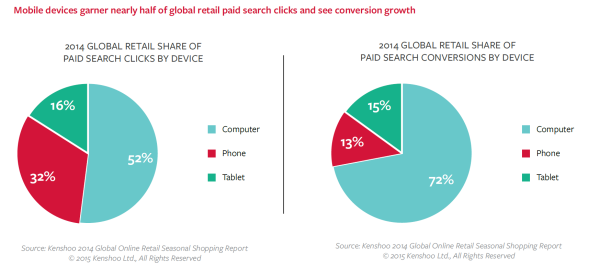Kenshoo’s analysis of global retail paid search advertising during the 2014 holiday shopping season suggests that mobile devices (phones and tablets) accounted for 48% of clicks on ads and 28% of conversions. These numbers illustrate the growing importance of mobile marketing today, but it is likely that mobile advertising and promotional activity actually has an even greater impact leading up to the final conversion.
In fact, with consumers now using a variety of devices to go online at different times of the day, one of the biggest challenges facing online advertisers and publishers is measuring the true impact of ads clicked on a variety of devices ahead of the final sale or conversion.
The scale of the challenge is put into context by a GfK study released last year which suggested that 60% of online adults use at least two devices every day. While a quarter (25%) of online Americans and a fifth (20%) of online Britons actually use three devices. And more to the point – 40% of people in both countries sometimes start an activity on one device only to finish it on another.
So how is it possible to unravel and estimate the impact of ads seen and clicked on different devices before the final sale or conversion? As you can imagine, a lot of companies are trying to solve this cross-device attribution puzzle.
One approach – called the deterministic model – works by matching the activity of logged in users across multiple devices. For example when a person uses the same email address to log into an app and a website, it is possible to create a cross-device match. As long as a user is logged in across devices using unique identifiers such as an email address, advertisers and publishers can use this to track their activity across multiple screens.
Google is using this deterministic approach in its Estimated Total Conversions reporting for search ads clicked from different devices. Facebook is also using the deterministic approach in its Cross-Device Reporting for Facebook ads, enabling advertisers to see for the people are moving between devices
Using logged in data can be very accurate, but the problem with this approach is that few companies have access to enough data to be meaningful. It’s also true that not all users will stay logged in across all devices – or that some people have multiple logins or use different usernames and email addresses on different devices.
The other approach for tackling the cross device attribution challenge is probabilistic matching, used by companies such as Drawbridge. Probabilistic matching collects a variety of non-permanent, user-resettable data points such as device type, operating system, IP address, Wi-Fi network, cookies, etc., and uses big data applications and machine learning to algorithmically match a person or household across devices.
For example, if a phone, a tablet and a laptop connect to the same Wi-Fi hotspots in the same places every weekday, it’s probably safe to assume they all belong to the same commuter. In fact, probabilistic methodologies have been shown to be as high as 97% accurate in matching devices.
No approach or solution is 100% perfect however, and businesses should strive to use as much data as they can to try and get insights about cross-device conversions and sales.
It’s also important to remember that correctly attributing credit to mobile and other devices along the purchase journey only solves part of the cross-device marketers’ challenge. The next step is to have agile processes and technologies in place to support real-time decisions based on that attribution information. So for example, brands should be able to connect their attribution engine to their bid management platform in order to adjust their digital advertising spend in real time.






